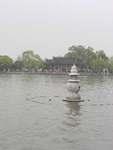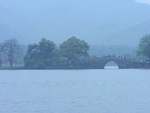The City of Heaven---Hangzhou
Today, tourists from around the world as well as many expatriates based in Shanghai looking to escape for the weekend flock to the capital of Zhejiang to drink in its beauty, making it one of China's busiest resorts. Any visit to Hangzhou would be incomplete without seeing West Lake. The clearwater lake was originally a shallow inlet. Around the fourth century AD, river currents and tides began depositing silt on the eastern part of the lake, eventually forming the present day lake. Although the view of the southern and western rim of the lake are now marred by office buildings and skyscrapers, the northern and eastern area of West Lake is surrounded by trees, hills, pavilion and pagodas, creating a splendid view.
West Lake's attraction lays in its seamless integration of its natural beauty with Chinese culture. The Zhejiang Provincial Museum, which exhibits ancient Chinese artifacts, the Autumn Moon on a Calm Lake Paviliion, now converted into a tea house, and Xiling Seal Engravers' Society are all located along the shores of West Lake. Hangzhou's best-known restaurant, Louwailou, is on the northern shore of West Lake, next to the Zhejiang Provincial Museum. It's famous for its dongpo pork, fish shred soup and beggar's chicken (a whole chicked cooked inside a ball of mud). One block off the northwestern part of West Lake on Renhe Road is Zhiweiguan Restaurant. It's known for its dim sum such as xiao longbao (small dumplings stuffed with meat) and mao erduo (fried, crunchy stuffed dumplings). The take-out style downstairs is good for a quick meal on the run while upstairs is better suited for more formal dining. On the western tip of West Lake is one of Hangzhou's biggest tourist attractions - the Yuefei Mu (Temple and Tomb of Yuefei). Yue Fei is one of two Chinese generals ever to be deified. Beginning in 1125 AD, the Manchus invaded northeast China. Yue Fei led his troops against the Manchus and successfully repelled the invasion. However, Emperor Gaozong and the jealous Prime Minister Qin Hui surrendered to the Manchus and falsely accused Yue Fei of treachery. At the age of 39, Yue Fei was poisoned to death in present day Hangzhou. While Emperor Gaozong was alive, no one dared to give him a proper burial, but Gaozong's successor annulled all charges against Yue Fei and reburied him at Yuefei Mu with full honors. Across from Yue Fei's tomb are cast-iron statues Prime Minister Qin Hui, Emperor Gaozong and two other co-conspirators kneeling in shame, with their hands tied behind their backs. Before, visitors would take off their shoe to use it to hit the statues and spit on them. Now, there's a "Do Not Spit" sign posted next to the statues so Chinese tourists have to settle for slapping the four traitors on the back of the head. In 1221, a temple was built next to Yue's tomb in his memory. The temple has been renovated several times over the centuries. Interestingly, in the museum, there's an exhibit with pictures of the destruction of Yuefei Mu incurred during the Cultural Revolution. Hangzhou's most famous sights - Feilai Feng (The Peak that Flew from Afar) and Lingyin Si (Soul's Retreat Temple) are not on West Lake, but a fifteen-minute taxi ride away from the city. Not surprising considering that in the old times, monasteries were built outside the city so monks could seek refuge from the city. Feilai Feng derived its name from an Indian Buddhist who thought that the hill of stone reminded him of a mountain peak back home in India and asked if it had flown here. More than 470 stone carvings of Buddhist figures which date from the 10th to 14th centuries cover the slopes of Feilai Feng and inside its caves. However, the stone carvings in Feilai Feng tend not be as well preserved as similar carvings in the North. The figures in the North were carved in marble, but the Buddhist sculptures carved in Hangzhou were made in the softer limestone, making them more susceptible to damage. Past Feilai Feng is Lingyin Si, one of the largest temple complexes in China. Soul's Retreat Temple, built in 326 AD by the Indian monk Hui Li, is recognized as one of China's ten famous Zen temples and the Monastery of Soul's Retreat is the largest and most important monastery in Hangzhou. Buddhists still come to Lingyin Si today to burn incense and pray. For non-Buddhists, it's still worth visiting for its architecture and the eighteen-meter high statue of Sakyamuni, the tallest statue of Sakyamuni standing up in Asia. The temple has been destroyed as a result of wars and other calamities at least sixteen times. During the Cultural Revolution, the Feilai Feng and Lingyin Si complex was one of those protected by Premier Zhou Enlai. The complex is currently undergoing expansion, with plans to increase its scale five times larger than its present size in three years. | ||
| Please visit People's Daily Online --- http://www.peopledaily.com.cn/english/ |

